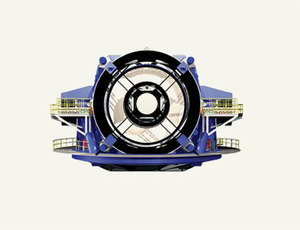
|
| ©LSST Corporation |
| A proposed design of the LSS Telescope, which will provide panoramic coverage of the sky and help detect near-Earth objects. |
"Chances are we're not going to discover one of these before it hits," Boslough says, pointing out that the vast number of small NEOs far outweighs the capabilities of the few surveys currently seeking them. "The good news is most of the Earth is either sparsely populated or uninhabited, so the probability a city or populated area will be hit is small. The big ones, 1 kilometer or larger, are the ones we should worry about."
While space agencies, governments, and individuals worldwide work to develop new means to detect, and eventually prevent, an NEO disaster, the US government - though it provides the global majority of NEO research funding - is mostly paying lip-service to a risk that could threaten the survival of civilization. In 2005, the US Congress built off mandates from the 1990s, directing NASA to catalog 90 percent of potentially hazardous NEOs greater than 140 meters in diameter by the year 2020. Congress also asked NASA to study ways to deflect threatening NEOs. But burdened with completing the International Space Station and replacing the Space Shuttle fleet, NASA has yet to allot funds to the project. Stagnant science budgets also threaten the Arecibo radio telescope in Puerto Rico, the top facility for studying NEOs. Citing budgetary limitations, NSF announced last year it will defund Arecibo's operation after 2010.
"Most Americans have faith that the federal government is doing what's necessary to protect us against threats that could destroy our country or leave large numbers of Americans dead," says US Representative Dana Rohrabacher, who introduced legislation last December calling for NASA to devote more resources to NEO research. "The fact that we haven't even formulated what our reaction would be to a potential threat from space is disturbing, considering the magnitude of the risk involved. You'd think there would be a plan ready, but there isn't."
Increasingly, coordinated private efforts are working to fill the gap in Earth's NEO defenses. Motivated in part by the upcoming US presidential election, leading space scientists recently attended an invite-only workshop at Stanford University to discuss shifting NASA's priorities away from a return to the Moon and toward manned missions to NEOs. And the B612 Foundation, a group co-founded by Apollo astronaut Rusty Schweickart, is gathering funds to test deflection strategies on an NEO by 2015. Earlier this year, Microsoft alumni Bill Gates and Charles Simonyi donated a combined $30 million to the Large Synoptic Survey Telescope (LSST), keeping it on track for first light in 2014. One of LSST's chief missions is to detect and catalog NEOs. As for Arecibo, Jim Cordes, a Cornell astronomer who frequently works at the observatory, says that in the absence of government funding, a consortium of universities may have to step in to fund the facility's operations beyond 2010.
Schweickart summarized what's at stake in a prepared statement at a November 2007 Capitol Hill hearing, where NASA and Congress clashed over how to address the NEO threat: "If we live up to our responsibility, if we wisely use our amazing technology, and if we are mature enough, as a nation and as a community of nations, there may never again be a substantially damaging asteroid impact on the Earth. We have the ability to make ourselves safe from cosmic extinction. If we cannot manage to meet this challenge, we will, in my opinion, have failed to meet our evolutionary responsibility."



Reader Comments
to our Newsletter